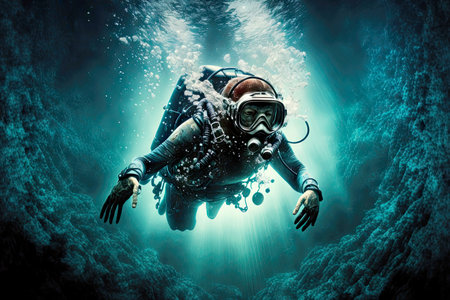DIVING AND ASTHMA NAVIGATING SAFELY BELOW THE SURFACE

Diving offers a fascinating opportunity to explore the underwater world, but it can present additional challenges for those with asthma. This respiratory condition, characterized by the narrowing of the airways, can complicate the diving experience. However, with proper management and planning, many people with asthma can enjoy diving safely. Here, we’ll explore the relationship between asthma and diving, including epidemiology, symptoms, management, and international guidelines.
Epidemiology of Asthma
Asthma affects a significant portion of the population in the United States. According to the Centers for Disease Control and Prevention (CDC), around 25 million Americans suffer from this condition, with an incidence rate of 7.7% in adults and 8.4% in children. Asthma is more prevalent in adult women compared to men, and approximately ten deaths related to asthma occur daily. The high incidence of asthma highlights the importance of proper management, especially for those engaging in physically demanding activities such as diving.
Symptoms and Complications of Asthma
Asthma causes the airways to narrow, which can limit airflow to the lungs. This effect can be exacerbated in diving contexts, where additional resistance from the equipment and the increased density of the inhaled gas can intensify symptoms. An asthma attack while diving can lead to difficulty breathing, which might cause panic and, in severe cases, pose a life-threatening risk to the diver.
Typical asthma symptoms include cough, wheezing, and shortness of breath, especially during and after physical exertion. Underwater, these symptoms can increase the risk of gas trapping, pulmonary rupture, or arterial gas embolism, making careful management of the condition crucial.
Asthma Management and Diving
Asthma treatment varies based on the severity of the condition and is categorized into four main types:
Intermittent Mild Asthma: Symptoms occur less than once a week. Treatment generally involves short-acting bronchodilators as needed.
Persistent Mild Asthma: Symptoms occur more than once a week and may affect sleep. Treatment typically includes short-acting bronchodilators during the day and long-acting bronchodilators at night.
Persistent Moderate Asthma: Symptoms can occur daily and may interfere with physical activities. Treatment includes inhaled corticosteroids and short-acting bronchodilators for acute episodes.
Persistent Severe Asthma: Symptoms are continuous and severely limit physical activity. Intensive treatment is required, including oral corticosteroids and long-acting bronchodilators.
For divers, maintaining normal lung function through effective asthma control is essential for safe diving. Proper management allows for a safe and effective diving experience.
International Guidelines and Medical Evaluations
Policies on diving with asthma vary between countries. In the United Kingdom, diving is permitted for individuals with well-controlled asthma, provided they have not needed a bronchodilator in the past 48 hours and do not have asthma triggered by cold, exercise, or emotions. In contrast, Australia adopts a more conservative approach, requiring all divers to undergo pulmonary function tests to rule out asthma before certification.
For those interested in diving, a thorough evaluation of lung function and an exercise test are crucial to determine the severity of asthma. Consulting with a physician specializing in diving medicine and asthma treatment provides the best guidance for ensuring a safe dive. It is also important to keep an inhaler on hand and inform the dive operator of any potential complications.
Conclusion
Diving can be an exciting and rewarding activity for individuals with asthma, provided that appropriate precautions are taken. Effective asthma management and proper medical evaluation enable many divers to enjoy the underwater world safely. The key is preparation: understanding and controlling the condition, following country-specific guidelines, and consulting with specialized medical professionals. With these measures in place, diving can be a safe and enjoyable experience, regardless of respiratory conditions.
Epidemiology of Asthma
Asthma affects a significant portion of the population in the United States. According to the Centers for Disease Control and Prevention (CDC), around 25 million Americans suffer from this condition, with an incidence rate of 7.7% in adults and 8.4% in children. Asthma is more prevalent in adult women compared to men, and approximately ten deaths related to asthma occur daily. The high incidence of asthma highlights the importance of proper management, especially for those engaging in physically demanding activities such as diving.
Symptoms and Complications of Asthma
Asthma causes the airways to narrow, which can limit airflow to the lungs. This effect can be exacerbated in diving contexts, where additional resistance from the equipment and the increased density of the inhaled gas can intensify symptoms. An asthma attack while diving can lead to difficulty breathing, which might cause panic and, in severe cases, pose a life-threatening risk to the diver.
Typical asthma symptoms include cough, wheezing, and shortness of breath, especially during and after physical exertion. Underwater, these symptoms can increase the risk of gas trapping, pulmonary rupture, or arterial gas embolism, making careful management of the condition crucial.
Asthma Management and Diving
Asthma treatment varies based on the severity of the condition and is categorized into four main types:
Intermittent Mild Asthma: Symptoms occur less than once a week. Treatment generally involves short-acting bronchodilators as needed.
Persistent Mild Asthma: Symptoms occur more than once a week and may affect sleep. Treatment typically includes short-acting bronchodilators during the day and long-acting bronchodilators at night.
Persistent Moderate Asthma: Symptoms can occur daily and may interfere with physical activities. Treatment includes inhaled corticosteroids and short-acting bronchodilators for acute episodes.
Persistent Severe Asthma: Symptoms are continuous and severely limit physical activity. Intensive treatment is required, including oral corticosteroids and long-acting bronchodilators.
For divers, maintaining normal lung function through effective asthma control is essential for safe diving. Proper management allows for a safe and effective diving experience.
International Guidelines and Medical Evaluations
Policies on diving with asthma vary between countries. In the United Kingdom, diving is permitted for individuals with well-controlled asthma, provided they have not needed a bronchodilator in the past 48 hours and do not have asthma triggered by cold, exercise, or emotions. In contrast, Australia adopts a more conservative approach, requiring all divers to undergo pulmonary function tests to rule out asthma before certification.
For those interested in diving, a thorough evaluation of lung function and an exercise test are crucial to determine the severity of asthma. Consulting with a physician specializing in diving medicine and asthma treatment provides the best guidance for ensuring a safe dive. It is also important to keep an inhaler on hand and inform the dive operator of any potential complications.
Conclusion
Diving can be an exciting and rewarding activity for individuals with asthma, provided that appropriate precautions are taken. Effective asthma management and proper medical evaluation enable many divers to enjoy the underwater world safely. The key is preparation: understanding and controlling the condition, following country-specific guidelines, and consulting with specialized medical professionals. With these measures in place, diving can be a safe and enjoyable experience, regardless of respiratory conditions.
